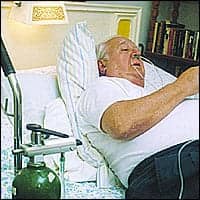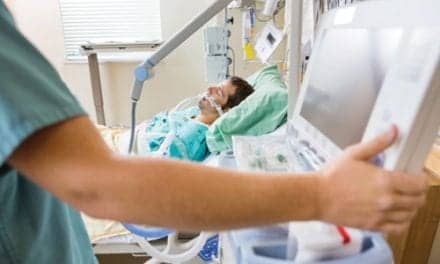
Paralyzed and on a respirator since a horseback riding accident 8 years ago, actor Christopher Reeve can now breathe for up to 2 hours on his own due to an experimental treatment, The New York Times reported March 13.
Reeve is only the third person to undergo diaphragm pacing via laparoscopy, a procedure that the US Food and Drug Administration approved for 35 patients, according to the article.
The treatment involves using a laparoscope to locate phrenic nerve motor points in the left and right diaphragm muscles. At these sites, surgeons implant intramuscular electrodes and attach them through wires under the skin to a small external battery pack. The battery stimulates the muscle and the phrenic nerves, causing the muscle to contract and air to enter the lungs, according to researchers at Case Western Reserve University in Cleveland.
Raymond Onders, MD, who performed the procedure at the University Hospitals of Cleveland on February 28, told the newspaper that Reeve’s results were extremely promising. And, according to the Times, Reeve can speak normally without the respirator and, for the first time in 8 years, can smell.
HIPAA Privacy Rule Takes Effect
Time is up to prepare for one major component of the Health Insurance Portability and Accountability Act of 1996 (HIPAA). The privacy rule, part of a set of standards required under HIPAA’s “administrative simplification” provisions, takes effect April 14. The regulation protects medical records and other personal health information. In other HIPAA news, in February, the US Department of Health and Human Services (HHS) published in the Federal Register the final security standards for protecting individually identifiable health information when it is maintained or transmitted electronically. The security standards will be effective April 21. After that date, most covered entities will have 2 full years—until April 21, 2005—to comply with the standards. Both final rules are available online at www.hhs.gov/ocr/hipaa.
EPA Shows Pollution Health Risks to Kids
An Environmental Protection Agency (EPA) report released in February revealed that the percentage of children with asthma more than doubled in the past two decades despite a reduction in child exposure to secondhand smoke. Called “America’s Children and the Environment: Measures of Contaminants, Body Burdens, and Illnesses,” the report also showed that in 2001, about 6% of all children had experienced an asthma attack in the previous 12 months. According to the EPA, genetic factors, family income, and race/ethnicity played a role in children who had an attack. Yet, it also cited that chronic exposure to ozone and indoor air pollutants, such as nitrogen dioxide, pesticides, plasticizers, and volatile organic pollutants, may cause or exacerbate asthma. The full EPA report is available at: www.epa.gov/envirohealth/children.
| Seattle To Host ATS Annual Meeting New research findings connected with the prevention, diagnosis, and treatment of respiratory disorders, along with those from critical care medicine, will be presented May 16–21 at the 99th international conference of the American Thoracic Society (ATS). The meeting, to be held in Seattle, will feature more than 5,800 podium and poster presentations and more than 15,000 registrants. For more information or to register, visit the ATS Web site at www.thoracic.org or call (800) 650-6898. Pediatric Severe Sepsis Poses Major Threat, Research Finds The authors based their research on seven state hospital discharge databases from 1995, the most recent year for which complete data were available. Writing in the American Journal of Respiratory and Critical Care Medicine, R. Scott Watson, MD, MPH, of the Department of Critical Care Medicine, University of Pittsburgh, along with five associates, pointed out that this incidence results in the use of an estimated 1.3 million hospital days annually at a cost of $1.97 billion (adjusted to 2001 dollars). They found that infants were at highest risk, especially low–birth-weight babies. Also, boys were more likely to develop sepsis and to die from the disease. “The number of children hospitalized with severe sepsis is roughly half the number hospitalized with appendicitis,” Watson said. “Our estimate of severe sepsis-associated deaths represents 7% of all deaths in children in 1995 and is greater than the 2,275 pediatric deaths associated with cancer that year.” The seven databases included in the study were from Florida, Maryland, Massachusetts, New Jersey, New York, Virginia, and Washington. Of the 9,675 children with severe sepsis in those states during 1995, 993 (10.3%) died. |










